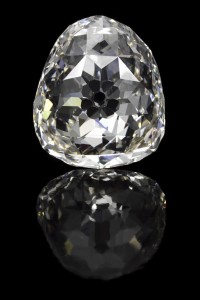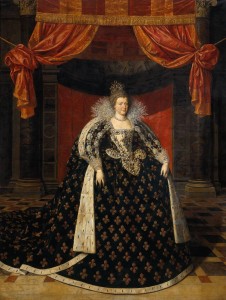 Georg Friedrich Ferdinand, Prince of Prussia, head of the Imperial House of Hohenzollern and great-great-grandson of Wilhelm II, the last Kaiser of Germany, is selling a diamond that has been part of the crown jewels of France, Holland, England, Prussia and the German Empire. Known as the “Beau Sancy,” the 35-carat modified pear double rose cut diamond is thought to have been mined near the south-central Indian city of Golconda, the same mines that produced the Hope Diamond.
Georg Friedrich Ferdinand, Prince of Prussia, head of the Imperial House of Hohenzollern and great-great-grandson of Wilhelm II, the last Kaiser of Germany, is selling a diamond that has been part of the crown jewels of France, Holland, England, Prussia and the German Empire. Known as the “Beau Sancy,” the 35-carat modified pear double rose cut diamond is thought to have been mined near the south-central Indian city of Golconda, the same mines that produced the Hope Diamond.
It was purchased in 1570 in Constantinople by diplomat, financier and famed jewel expert Nicolas de Harlay, Lord of Sancy. Harlay also owned a 55.23-carat shield-shaped yellow diamond called the “Sancy” so the smaller, whiter gem came to be called the “Beau Sancy” or “Little Sancy” to distinguish it from its cousin. An avid monarchist, Harlay sold high-end gems to raise money for King Henry III of France’s wars. He loaned both Henry III and Henry IV the “Sancy” diamond. The former king borrowed it to wear on the cap he used to cover his baldness; the latter used it as collateral to finance yet another war.
Harlay owned both spectacular stones for decades, entering into years of negotiations with potential buyers like the Duke of Mantua which went nowhere. He finally sold the “Sancy” to King James I of England around 1604. Legend has it that when Marie de’ Medici, wife of King Henry IV of France, found out that the biggest Sancy stone was now in the clutches of the English monarchy, she was so furious that Henry bought the “Beau Sancy” to appease her. He gave it to her as a gift.
 Marie had it set at the top of the crown she wore at her coronation on May 13, 1610. There’s a formal portrait of Marie in full coronation regalia by Frans Pourbus the Younger in the Louvre which depicts the “Beau Sancy” at the apex of her crown. Unfortunately for Marie, on May 14, 1610, her husband was assassinated. Marie was made regent for her eight-year-old son, Louis XIII, and was by all accounts awful at it. Louis had to claim his own throne by force in 1617 and exile his mom to French hinterlands.
Marie had it set at the top of the crown she wore at her coronation on May 13, 1610. There’s a formal portrait of Marie in full coronation regalia by Frans Pourbus the Younger in the Louvre which depicts the “Beau Sancy” at the apex of her crown. Unfortunately for Marie, on May 14, 1610, her husband was assassinated. Marie was made regent for her eight-year-old son, Louis XIII, and was by all accounts awful at it. Louis had to claim his own throne by force in 1617 and exile his mom to French hinterlands.
She kept intriguing against Louis’ rule and against his puppet master/advisor Cardinal Richelieu in various countries for the next 25 years. In 1641 she was in Amsterdam and deep in debt. To pay off some of her creditors, Marie de’ Medici sold the “Beau Sancy” to Frederick Henry, Prince of Orange-Nassau, for a staggering 80,000 florins, the single largest expenditure in the state budget for that year.
Prince Frederick Henry’s grandson William III of Orange inherited the stone. He gave it to his wife Mary as a wedding gift. After Catholic King James II of England was overthrown in the Glorious Revolution of 1688, the couple ascended the throne of England as King William III and Queen Mary II. They brought the “Beau Sancy” with them to England, and James II took the “Sancy” with him when he fled to France. Broke and dependent on his cousin King Louis XIV, James II sold the “Sancy” to Richelieu’s protégé Cardinal Mazarin who in turn left it to the Sun King in his will. The “Sancy” disappeared during the French Revolution but reappeared on the market in 1828, going through various hands until it was sold to the Louvre in 1978 by William Waldorf Astor, 4th Viscount Astor.
Meanwhile, William and Mary died childless, so after their deaths the “Beau Sancy” went to another grandson of Prince Frederick Henry’s, Frederick III, Elector Prince of Brandenburg and as of 1701, King Frederick I of Prussia. The diamond was considered the most important stone in the crown jewels and was worn by every royal bride until the dissolution of the monarchy after World War I. When Kaiser Wilhelm II abdicated as German Emperor and King of Prussia and fled to the Netherlands in November 1918, the diamond stayed in Berlin.
It was kept in a sealed crypt for safekeeping during World War II. British troops discovered the stone after the war and returned it to the House of Hohenzollern where it has remained ever since. On May 14, “Beau Sancy” will be put on the auction block at the Sotheby’s Geneva Magnificent Jewels and Noble Jewels sale.
The diamond will tour the world before then, stopping at Sotheby’s showrooms in Hong Kong, New York, Rome, Paris, London and Zurich before arriving at its destination in Geneva. “Beau Sancy” has only been on public display four times over the past 50 years, so it’s a rare opportunity. Who knows where it will end up after it’s sold. Philipp Herzog von Württemberg, chairman of Sotheby’s Europe, expressed a hope that the French government would buy the stone so the two historic Sancy diamonds could be together again at the Louvre, but I suspect that’s a pipe dream. The pre-sale estimate is $2 million – $4 million. I suspect those numbers are a pipe dream too.